
It’s been a while since the words ‘New Homeworld’ have been muttered, but it’s finally here. A real, not kinda-maybe-happening sequel for Homeworld, and it’s… Set on a planet!? The ground might seem like a strange place to set a story about vast space-faring civilisations, but trust me, it makes for one hell of a game. It’s a much more personal experience, filled with deep mechanics that emphasise positioning as much as solid unit composition. Simply put, it’s a good Homeworld sequel.
Deserts of Kharak tracks the first pilgrimage of the Higaraan people, who are still known as the Kushan. The aim of this pilgrimage is to lead an expedition carrier, the Kapisi, across the desert and reach the “Primary Artefact”, which we all remember is the location of the hyperdrive core. The problem is, it’s located past Gaalsian territory, a fanatical tribe obsessed with the holy teachings of The Great Maker, Sajuuk. Unlike other Homeworld games, however, this is as grand as it gets, and it’s nowhere near the enormous scope of the other games, both in world-building and storytelling.
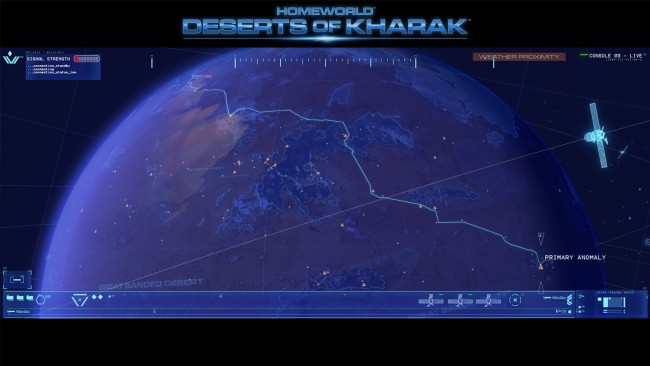
Because DoK is set on a planet instead of outer space, the scale of the narrative is on a far more personal level. Instead of gallivanting through space with your entire populace in tow and learning about the destruction of entire civilisations, DoK focuses on the people involved in the journey. The main protagonist is Rachel S’Jet, and we are exposed to her responses to what is discovered and what is lost throughout the pilgrimage. We also hear audio logs between missions that give the characters a bit (but not a whole lot) of personality, which is almost unheard of in Homeworld games. It’s a pleasant change of scale, but it’s not quite as awe-inspiring as the old games.
Upon finishing the game (and not revealing spoilers), I couldn’t help but feel the whole story was a bit lacklustre. Yes, the personal approach seems more appropriate given the scale of the game, but the melodrama wasn’t very compelling. The old Homeworld mantra of “Everyone are dicks, including you” still rings true, but the revelations feel insignificant compared to the older games. It has its moments, and it’s by no means an exercise in tedium, but it’s not as awe-inspiring as the oldies.
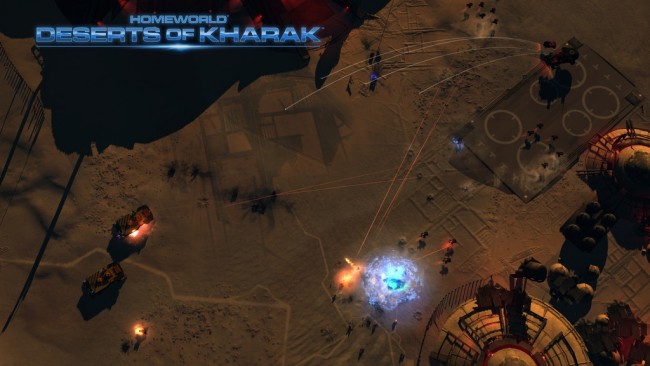
Alright, let’s talk about moving the game from space down to the ground, because once you stopping frothing at the mouth with rage, you’ll see it’s brilliance. Imagine if the counter system of Homeworld met the line of sight mechanics of Ground Control and had a beautiful child called Deserts of Kharak. It’s a fantastically deep system, taking the unit structure of the old games and adding a layer of positioning into the design. In my opinion, it’s a better design than the predecessors, and some important distinctions really set DoK apart.
The biggest mechanical difference is the focus on positioning. Because the desert is a dune-filled nightmare, the hills of sand stop units from firing at one another because they get in the freaking way. On top of that, if you’re on higher ground than your enemy, you’ll get a bonus to how much damage the units will do, so positioning is a lot more meaningful than the previous games. It’s not just about moving to surround a ship; it’s about being able to fire at the enemy in the first place. The other big difference is your expedition cruiser’s ability to do anything, because it’s way better than your mothership ever was.
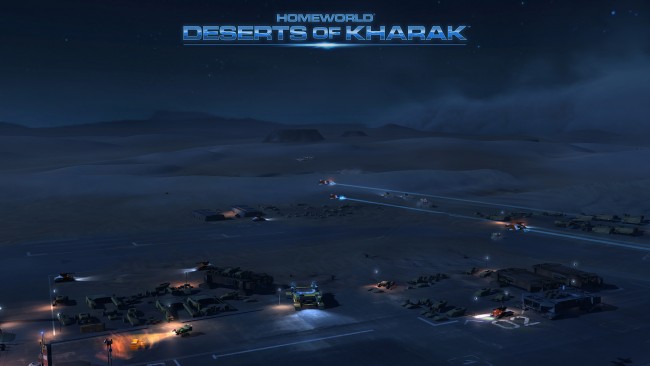
Your expedition carrier is a lot more than a glorified resource drop-off point; it’s a capable unit able to hold its own in combat. However, what it does is decided by a power management system, so it can help repair your units or act as an effective AA emplacement. Of course, because the dunes can get fairly steep, it can only take certain paths and set up shop in certain areas, and it makes the positioning feel like more than just a gimmick. Overall, it’s a delightfully satisfying system, but it doesn’t always work as well as it potentially could.
For the most part, DoK is just as Homeworld-ey as anything you’ve played before. The camera and units work the same, the iconography is the same, and it feels like a Homeworld game despite being on the ground. There are some nice changes, like an indicator in the sensors screen to show you where you’re centred, and for the most part, it works wonderfully. Of course, nothing is perfect, and a new Homeworld game is no exception.
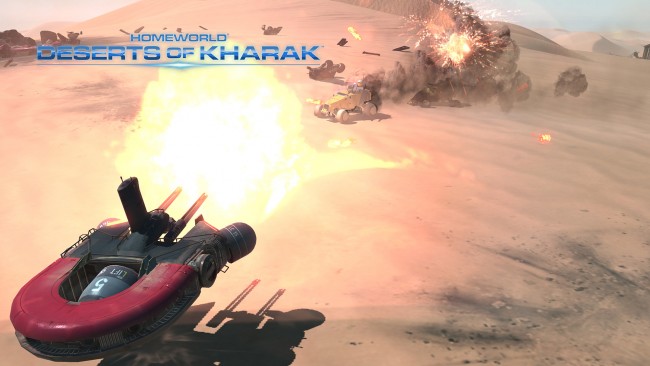
For a game that has such a heavy focus on positioning, there’s no convenient way to utilise it. The old games had formations, and depending which ones you used, they could be the defining factor in who won the firefight. In DoK, there are no formations, but there isn’t even a way to specify what direction your units face or which ones get in front of the others. The lack of designating ranks can be hugely problematic if you want several cruisers to be in front of other cruisers but you don’t want to micromanage every single unit into the desired formation every time you move them. The other gripe I have with the game is the complete stupidity of the units themselves.
When you order your units around, you’d hope they hold a modicum of common sense, but alas, this is not the case in DoK. Instead of firing at the units they’re effective against, units will fire at whoever’s conveniently in their line of sight. So, without the micro of a prophetic Karen S’Jet, your units will act like headless six-year-olds with high-powered weaponry. These brain-dead units, coupled with the inability to quickly and efficiently position units, can detract from the otherwise brilliant design.

Homeworld has always been a good looking game, and this instalment is no different. The vastness of space is replaced by the emptiness of the Kharaki desert, and it’s just as glorious. Seeing the desert fade off into the horizon as seamlessly as an old nebula sold me on the aesthetic of DoK, especially since this was no longer a game set in the empty void we all love. That same feeling of loneliness that was present in the old games has been re-contextualised to a more personal setting, but it can sometimes be at odds with what else is going on.
One of the things that the Homeworld Remastered Collection did very well was preserving the atmosphere of the old games, and this same atmosphere is present in DoK. The thing is, this isn’t the old Homeworld games, and the story is on a far more personal scale. So, the cold voice acting and clinical perspective of the characters seems at odds when you’re trying to relate to them. Still, when it comes to fostering that mood of distressing calm, DoK delivers as well as any of the other instalments, including the sound.
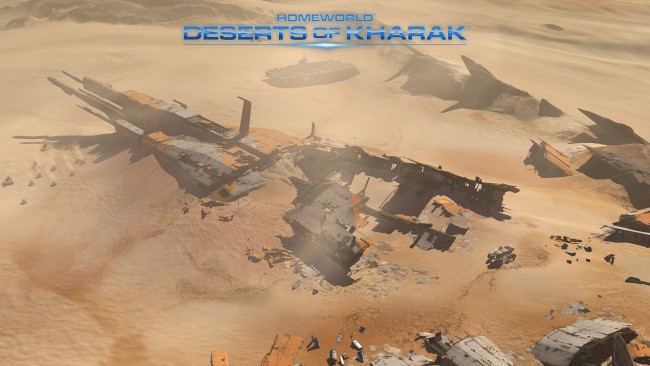
The sounds of Homeworld was one of the most crucial parts of the experience, setting the tone of the game and reinforcing the mood. DoK has adopted the personal approach in its sound design, with units chatting amongst themselves on the battlefield. The acting even has the slightest hint of emotion in it without compromising the classic Homeworld style. The music is certainly a touch more aggressive, but this also works within the game too, and it’s still atmospheric enough to stand amongst the other games’ soundtracks with pride.

Deserts of Kharak is a fantastic addition to the Homeworld franchise. Its brilliant design translates the game from space into a more personal and grounded setting, and despite some infuriating absences, it’s a thoroughly satisfying experience. The depth of the mechanics should be appealing to anyone interested in RTS games, and the atmosphere of the game will be a welcome return for any diehard Homeworld fans. Simply put, it’s just a damn good Homeworld sequel.
Editor Note: Multiplayer was not included in this review. Instead, it was reviewed separately, which you can read here.











